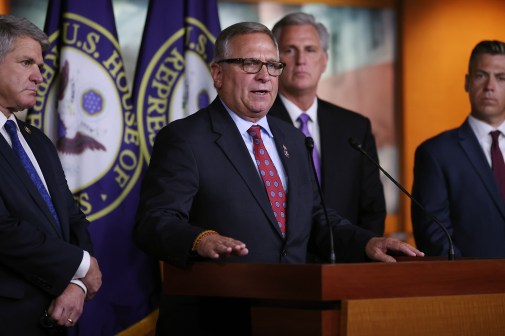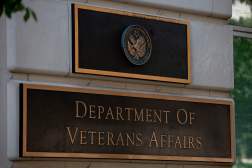House: VA gouged on hep C miracle drug it developed

The Department of Veterans Affairs is being gouged by the makers of a miracle cure one of its own researchers developed, a House committee said Wednesday.
The department is paying $40,000 per treatment for a hepatitis C drug a part-time VA researcher developed years ago due to the failure of a program that supposedly gets the department ownership of products created through its Office of Research and Development.
The House Committee on Veterans’ Affairs heard testimony Wednesday about Sofosbuvir, discovered by Raymond Schinazi — who spent much of his career as a part-time VA employee. Lawmakers said the VA should have some rights to the royalties accrued by sales of the drug, because it was developed at least in part though the department’s own research. Instead, the department is paying $40,000 per treatment, making it costly to help the more than 200,000 veterans with the disease.
The issue, said committee Chairman Rep. Jeff Miller, R-Fla., stems back to improper operation and management of the VA’s technology transfer program, which was conceived in 2000 to promote the commercialization of new products, ensure the proper negotiations of rights among the department, inventors and and third parties, and evaluate any inventions. The program was created so that medical products developed through VA research are recognized as such and to ensure “access to technologies by veterans,” according to the VA.
Past discoveries, such as the cardiac stent, the nicotine patch and the CT-scan, are said to have been inspired by the department’s work, but because they came prior to the technology transfer program, the VA received no ownership credit or revenue from them.
Compared to similar programs at other federal agencies, like the National Institutes of Health and the Department of Agriculture, the chairman said the VA earned far less in royalties from its research and filed far fewer invention disclosures, patents and license agreements in fiscal year 2014.
“VA’s technology transfer program was developed as the mechanism to determine ownership and then to transfer the benefits of VA owned technology to veterans and the public through patenting and licensing,” Miller said. “Unfortunately, this program appears to be habitually underused, resulting in tremendous losses to Veterans and taxpayers.”
Instead, Schinazi sold the drug to pharmaceutical company Gilead in 2012, raking in a $440 million personal profit on the $11 billion sale.
“VA appears to have nothing to show for it, except a bill from the drug’s current owner, Gilead Sciences, for VA’s use to treat veterans,” Miller said in his opening statement.
Miller and his committee believe Schinazi, while a VA employee, filed patents on the drug, which the transfer program should have prevented and instead distributed the intellectual property properly among the involved parties.
Many of the committee members were troubled that it took nearly four years for the VA to realize that the drug developed, at least in part, by VA researchers was the one being sold back to the department with such a steep price tag. And that only happened, the committee said, when Miller sent a letter to the department questioning issue.
“How hard would it be to recognize the problem?” asked Rep. Mike Coffman, R-Colo. “Somebody on your team develops this [drug], and VA contracts for it at about $40,000 per patient and can’t figure it out. How hard is that to do?” The $40,000 cost is said to be a 50 percent discount for what Gilead typically charges to Americans, though committee ranking member Rep. Corrine Brown, D-Fla., said it cost as little as $900 in Egypt. Nevertheless the VA spent more than $1 billion on it last year alone.
To make matters worse, Schinazi, first asked Jan. 20 to testify during the hearing suddenly retired from the VA just days before, filing his resignation the day following the committee’s request for his appearance, according to Miller. With more than 25 years service as a VA researcher, the committee suggested his sudden departure coincidentally around the time of the hearing signaled he was feeling from the accountability of his actions.
That’s a trend that is becoming a refrain within the VA, Coffman said.
“The person that’s responsible always seems to retire just before the investigation starts,” he said, comparing it to a $1 billion cost overrun scandal at a Colorado VA hospital last year. “This just fits the pattern.”
Ultimately, the accountability falls back on David Shulkin, the undersecretary of health for the Veterans Health Administration, just months into the job. Unfamiliar with the problem until Miller’s letter, Shulkin was mostly answerless to the committee’s prodding of what went wrong and how it would be fixed. He stopped short of giving the committee any specifics about Schinazi and continued to reiterate his earnest in improving the program despite knowing what about it is broken.
“I take this very seriously,” Shulkin told the committee. “I’m going to get to the bottom of this.”
But when asked if he, like many of the committee members, was outraged by this alleged failure of the program, he said, “I don’t know enough to be outraged. I am taking this very seriously, and I reserve the potential to be outraged. But I don’t know enough to be able to say that.”






